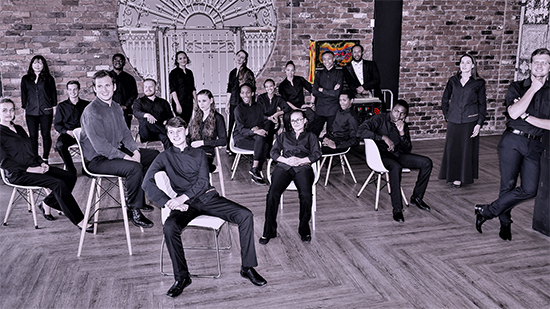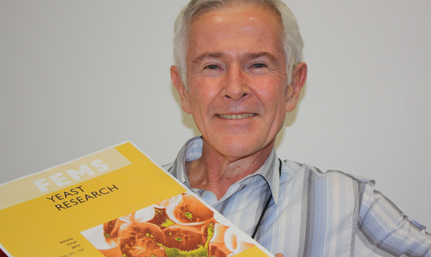Latest News Archive
Please select Category, Year, and then Month to display items
18 September 2018
Photo Hanno Otto
 The OSM Camerata is once again a winner, sharing the first prize in the Ictus International Music Competition with the Oklahoma State University.
The OSM Camerata is once again a winner, sharing the first prize in the Ictus International Music Competition with the Oklahoma State University.
If Einstein’s string theory had a musical undertone, one would think it is because of the sweet melodies of the Odeion School of Music Cameratas’ (OSMC) violins and cellos. It should therefore come as no surprise that OSMC won the 2018 International Ictus Music Competition, again. The ensemble has been paving the way to numerous successes since its inception in 2012.
This year, however, the OSMC is sharing the first prize with the Oklahoma State University Symphony Orchestra, under the direction of Dr Thomas Dickey. The OSMC’s competition recital for 2018 was conducted by principle conductor, Xavier Cloete. Acclaimed violist Elsabé Raath, joined the OSMC artistic team in 2017 as string clinician.
OSMC the jewel in crown
The OSMC is based at the Odeion School of Music (OSM) at the University of the Free State UFS) and was strategically founded as the OSM’s flagship ensemble with the main objective, creating a catalyst for excellence. “From a pedagogical perspective, it serves as a feasible incubator to nurture fully-rounded musicians who are thoroughly prepared for the demands of their trade as orchestral musicians, soloists and conductors,” said Marius Coetzee founder of the OSMC.
“Ms Raath also made her debut as conductor during the 2018 Ictus Music Competition where she conducted O Sacrum Convivium by Olivier Messiaen,” said Coetzee, founder of the OSMC. Elsabé was also conductor during the 2018 Ictus Music competition.
The OSMC’s concert programme for Ictus 2018 also consisted of works by Jacobus Gallus/Lance Phillip, Béla Bartók, Peteris Vasks/Keith Moss, as well as Johann Sebastian Bach.
Ictus an ideal platform
The Ictus International Music Competition is an online music competition for wind bands, orchestras and solo trumpet. It has been described by David Bilger of the Philadelphia Orchestra as “democratising music competitions”. Ictus was founded to make international music competitions more accessible though eliminating prohibitive travel costs, conference fees and visa issues. This was made possible through having the application and adjudication take place online only.
You can listen to OMSC Ictus submissions here:
Duo Seraphim Jabobus Gallus/Lance Phillip
Romanian Folk Dances/ Román népi táncok Béla Bartók
Kekatu Dziesma (Carnival Song) Peteris Vasks/Keith Moss
Link between champagne bubbles and the UFS?
2012-11-16
 |
|
Prof. Lodewyk Kock with an example of a front page of the publication FEMS Yeast Research, as adapted by F. Belliard, FEMS Central Office.
Photo: Leatitia Pienaar
15 November 2012
|
What is the link between the bubbles in champagne and breakthrough research being done at the Mayo Clinic in America? Nano research being done at our university.
Prof. Lodewyk Kock of Biotechnology says a human being consists of millions of minute cells that are invisible to the eye. The nano technology team at the UFS have developed a technique that allows researchers to look into such a cell, as well as other microorganisms. In this way, they can get an idea of what the cell’s “insides” look like.
The UFS team – consisting of Profs. Kock, Hendrik Swart (Physics), Pieter van Wyk (Centre for Microscopy), as well as Dr Chantel Swart (Biotechnology), Dr Carlien Pohl (Biotechnology) and Liza Coetsee (Physics) – were amazed to see that the inside of cells consist of a maze of small tunnels or blisters. Each tunnel is about 100 and more nanometres in diameter – about one ten thousandth of a millimetre – that weaves through the cells in a maze.
It was also found that these tunnels are the “lungs” of the cells. Academics doing research on yeast have had to sit up and take notice of the research being done at the UFS – to the extent that these “lungs” will appear on the front page of the highly acclaimed FEMS Yeast Research for all of 2013.
The Mayo Clinic, in particular, now wants to work with the UFS to study cancer cells in more detail in order to fight this disease, says Prof. Kock. The National Cancer Institute of America has also shown interest. This new nano technology for biology can assist in the study and development of nano medicine that can be used in the treatment of cancer and other life threatening diseases. Nano medicine uses nano metal participles that are up to one billionth of a metre in size.
Prof. Kock says laboratory tests indicate that nano medicine can improve the efficacy of anti-cancer medicine, which makes the treatment less toxic. “According to the Mayo Clinic team, nano particles are considered as a gold cartridge which is being fired directly at a cancer tumour. This is compared to fine shot that spreads through the body and also attacks healthy cells.”
“This accuracy implies that the chemotherapy dose can be lowered with fewer side effects. The Mayo Clinic found that one-tenth of the normal dosage is more effective against pancreas cancer in this way than the full dosage with a linkage to nano particles. According to the clinic, this nano medicine could also delay the spread of cancer,” says Prof. Kock.
The nano particles are used as messengers that convey anti-cancer treatment to cancer cells, where it then selectively kills the cancer cells. The transport and transfer of these medicines with regard to gold nano particles can be traced with the UFS’s nano technology to collect more information, especially where it works on the cell.
“With the new nano technology of the UFS, it is possible to do nano surgery on the cells by slicing the cells in nanometre thin slices while the working of the nano medicine is studied. In this way, it can be established if the nano medicine penetrates the cells or if it is only associated with the tiny tunnels,” says Prof. Kock.
And in champagne the small “lungs” are responsible for the bubbles. The same applies to beer and with this discovery a whole new reach field opens for scientists.